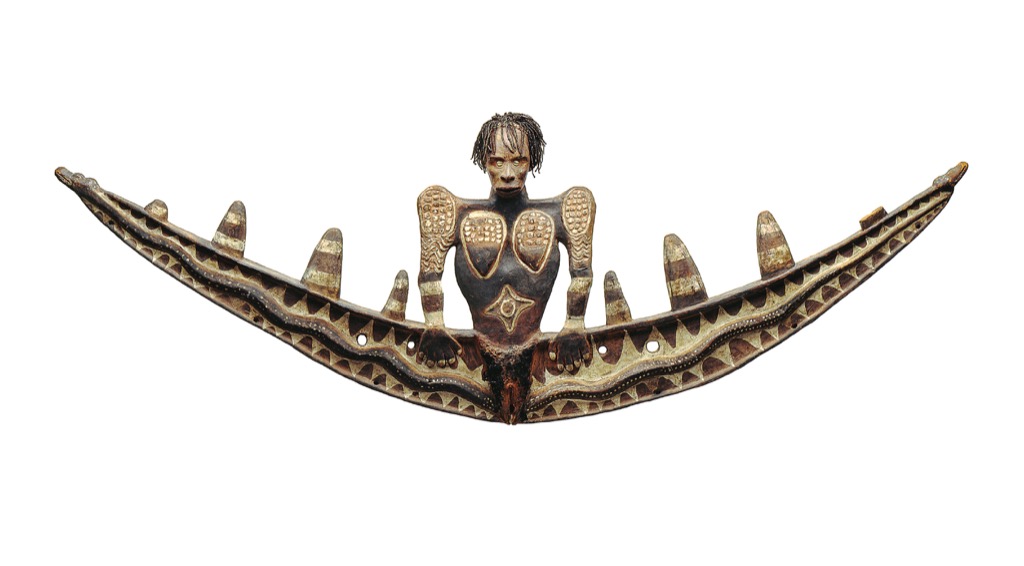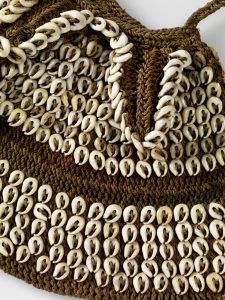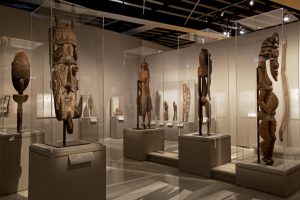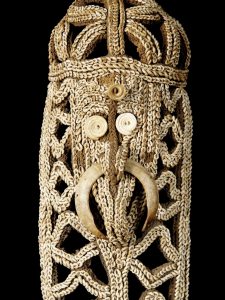The minute you enter the Sepik exhibition at Musée du quai Branly, you are transported to the other side of the world, watching fishermen on pirogues drifting on a very large river, the 1 126 km long Sepik. Since it was discoverers by Otto Finsch in 1886, the estuary of the Sepik in Papua-New Guinea (independent since 1975), just North of Australia, has been an object of study by German and Swiss scholars and the result of their discoveries is an incredible esthetic experience.

Polymorphic sculpture collected in 1955. This half human, half animal figure is one of the most curious pieces of the show.© Basel, photo Hughes Dubois

Façade mask from the village of Simar/Abramar, collected in 1909, © Dresden, Museum für Völkerkunde, photo Hans-Peter Klut
I was lucky to be able to follow Philippe Peltier, the curator of the show, who was commenting some of the 230 sculptures (first shown in Berlin and Zürich) for the radio. He went three times to Porapora, a village of lower Sepik and after being initiated to the language for 6 months by tribal men, he was taken on a crocodile hunt and went on daily chores with the villagers, including sculpting statues for the men’s houses. In 1991, he acquired many pieces for the Musée du quai Branly.
The aim of the show is to explain how Sepik art is entirely geared towards Grand Ancestors figures. How every single piece of daily object is sculpted, engraved and painted with animal or human faces. Villages are illustrated in this exhibition, with their men/women divisions and also a world parted in water/air.
Pictures by François Girard in the 1950’s and other exploratory from the beginning of the 20 th century, are fascinating documents and punctuate masks and sculptures window cases. The importance of sculpted pirogues, of gigantic hooks, an important part of the household used for hanging food, or precious belongings, is very new to us. Shell necklaces and pig’s teeth are symbolic of men’s power. Masks worn for ceremonies are lavishly decorated and sculpted. In the last part of the show, a music room allows you to listen to duets of flutes and other river music. It is a lovely halt in a bury exhibition!
It is very hard of course to learn in a couple of hours what this is all about, but the pure esthetic beauty of the objects shown here and beautifully displayed by Didier Blin’s scenography, is enough to entice you to go. Among all the breathtaking exhibitions in Jacques Chirac’s museum, this is one of the most intriguing and I would have loved to go home with the crocodile pirogue!
Share this Post




One Comment on “Sepik, a river to be discovered”
Bonjour Laure,
Bravo pour ton blog! Ca me donne très envie d’aller voir cette exposition. J’avais découvert les arts primitifs de Papouasie-Nouvelle Guinée dans l’aile qui leur est consacrée au Met (superbe contraste d’ailleurs entre ces pirogues et totems et la vue sur Central Park); et je suis admiratif de ce travail du bois qui transcende l’aspect fonctionnel en y mêlant des rites sacrés. Certaines de ces réalisations n’ont rien à envier sur le plan esthétique aux masques baoulés et autres sculptures fang .
Amitiés.
A bientôt!
Alexandre